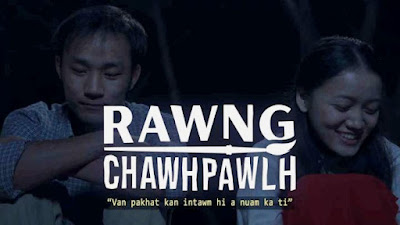- Ruata Lungchuang
The Mizo film industry has indeed come a long way, and 2023 stands as a remarkable year for Mizo cinema. This year has witnessed the release of numerous Mizo feature films and productions on the silver screen. While Mizo cinema may still lag behind larger film industries in the region, the sudden surge in growth reveals its profitability and the abundant talent within it. This surge underscores the immense potential of Mizo entertainment.
One of the latest additions to the Mizo film industry is the recently released movie 'Rawng Chawhpawlh,' produced by Green Rocket TV. This film marks the debut of Green Rocket TV, a production house initiated by a group of Mizo teenagers through a YouTube channel. It's both inspiring and encouraging to witness the transformation of the Mizo film industry, once dominated by mediocre movies under the monopoly of middle-aged men, now welcoming fresh production houses and youthful talents. This shift speaks volumes about the untapped potential of Mizo entertainment, exemplified by Green Rocket TV's journey from a humble YouTube channel to becoming a major production house in Mizoram.
The film's title, "Rawng Chawhpawlh," meaning 'Mixed Color,' perfectly encapsulates its storyline. The movie follows the love story and struggles of two villagers in Mizoram and their friends. It delves into seldom-discussed Mizo social norms and arrangements, including divisions within churches and unique Mizo concepts like the "chhungkaw chhehchhawl" or the family rug. A rug of the family and the daughter of a cult leader falling in love is definitely something that does not come up every day. The screenplay and story, penned by Raymond Colney, tackle serious topics while presenting them in a light-hearted manner, skillfully directed by Abarim Lalrammawia. The cinematography is striking, laden with symbolism and subtle scenes that portray Mizo societal norms in an exquisite yet nuanced fashion. The cast, including Tommy Rosangliana, Zoparmawii, Lalduhawmi, Lalchhandami, and Thangbiakzuala from the Green Rocket TV family, alongside seasoned Mizo actors and actresses such as Maruata Hnamte, Eddie Tochhawng, Maruata Rawite, and Rosangpuii Ralte, deliver flawless performances.
Regarding the storyline, I won't divulge spoilers, but it's worth noting Raymond Colney's audacious attempt to explore a rarely-ventured subject within Mizo cinema, executed admirably. One of the significant challenges faced by Mizo screenwriters is the endeavor to render dialogues and scenes more realistic and less theatrical. "Rawng Chawhpawlh" earnestly breaks from the traditional Mizo storytelling and dialogue style, presenting the story naturally and smoothly, with the actors' actions and dialogues feeling authentic and devoid of cringe-worthy moments. Director Abarim Lalrammawia's work is aesthetically pleasing, with night scenes, in particular, standing out for their spectacular lighting and tones, lending an otherworldly quality uncommon in Mizo cinema.
The screenwriter and director deserve credit for seamlessly incorporating aspects of Mizo culture into the film without overtly stating them. For instance, a funeral scene subtly portrays a Mizo funeral gathering, offering a glimpse into the roles played by different sections of Mizo society in a traditional setting. The music in the movie is also done quite well, however, it is a shame that Lawmi Chhakchhuak's voice and her beautiful performance of Gas Lak Ni which was the OST for the movie were not heard in the entirety of the film but only in the credit parts at the end of the movie.
Despite its numerous merits, "Rawng Chawhpawlh" may occasionally feel slow or lengthy, understandable given the complexity of the story and its intended message. The constraint of fitting the story into a runtime of less than two hours leads to certain scenes, intended for symbolic representation, taking more time than necessary, potentially inducing a sense of contemplation among viewers not accustomed to such cinematic moments. While the direction overall is praiseworthy, it appears as though some scenes received more attention than others, resulting in a somewhat uneven cinematic experience. While the beginning and ending parts of the movie are beautifully directed with impeccable colour and lighting, the middle section, particularly the Jhum field scenes, may feel less polished in terms of acting akin to an amateur YouTube production.
One notable aspect deserving of improvement is the portrayal of relatable female characters. While the film features several female characters, none establishes a strong connection with the audience due to their roles. The primary female characters are part of a cult, and the hero's sister, played by Rosangpuii Ralte, has limited screen time and is portrayed as a bully.
Regarding costume design, it's challenging to discern the movie's timeline or era, as the attire worn by the characters, aside from the creative costumes for cult members, may appear perplexing. The presence of cell phones suggests a contemporary setting, yet the hairstyles and fashion sense of the protagonist and his best friend evoke a 1970s fancy dress vibe, lacking resemblance to either 1970s fashion or modern style. This issue, portraying rural characters in eccentric attire, is a common pitfall in Mizo music videos and movies, and "Rawng Chawhpawlh" seems to have inadvertently fallen into this trap, possibly in an attempt to infuse comical elements or artistic expression. However, such artistic expression often fails to resonate with the audience unless consistently applied throughout the entire film, including its set design.
Overall, "Rawng Chawhpawlh" offers an immensely enjoyable cinematic experience, albeit with a somewhat contemplative pace, particularly for non-Mizo viewers who rely on English subtitles. This movie may not cater to everyone's taste, but for those seeking a thoughtful exploration and portrayal of Mizo religious systems and divisions, it is unquestionably a must-watch.
Rawng Chawhpawlh is available for streaming on Lersia Play
Dear readers, The Mizos is not a large organisation; We are a small independent media outlet from Mizoram trying to cover lesser-covered stories from Mizoram and the Northeast in English. You can always support us by contributing to our Buy Me a Coffee page here - https://www.buymeacoffee.com/themizos

